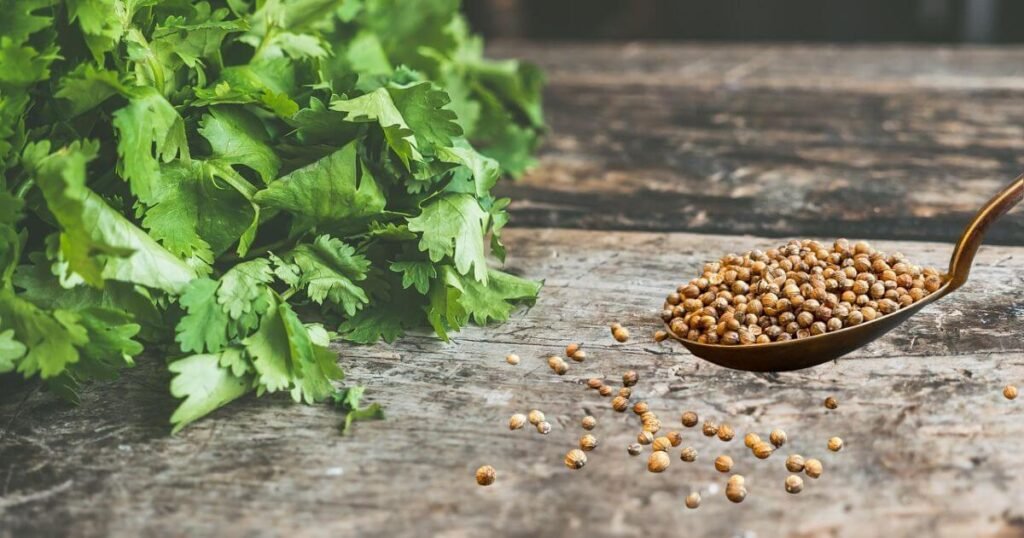Koriandri emerges as nature’s most versatile herb, where ancient Egyptians first recognized its magical properties beyond simple culinary use. This aromatic ingredient carries thousands of years of cultural significance, bridging Mediterranean origins with global kitchen applications. Fresh leaves deliver citrusy brightness while dried seeds offer warm, nutty depth to countless dishes. From Indian garam masala to Mexican salsas, koriandri transforms ordinary cooking into extraordinary culinary adventures.
Archaeological evidence from Tutankhamun’s tomb reveals how Romans and Greeks valued this fragrant plant for medicinal healing powers. Trade routes spread koriandri across continents, establishing its essential role in Asian, Middle Eastern, and Latin American cuisines. Modern chefs and home cooks continue celebrating its distinctive flavor profile, where cilantro leaves complement rich curries while coriander seeds enhance spice blends.
History and Origin of Koriandri
The ancient cultivation of this remarkable herb traces back thousands of years across diverse cultures and regions. Archaeological evidence suggests early civilizations in the Middle East and Mediterranean recognized its dual nature – both culinary and medicinal properties were valued equally. Traditional medicine systems incorporated these aromatic parts into religious rituals and healing practices. The plant’s scientific name Coriandrum sativum reflects its long association with human civilization.
Today’s global presence stems from ancient trade routes that carried these precious seeds across continents. India, Egypt, and Morocco became major agricultural centers, with each region developing distinct varieties and uses. Generations have handed down knowledge of cultivation techniques, ensuring fresh supplies remained available. The herb’s journey from wild plant to essential kitchen staple demonstrates humanity’s innovative approach to food and wellness.
Health Benefits of Koriandri
Koriandri serves as a nutrient-rich powerhouse, delivering essential vitamins and minerals that support overall wellness. Its bioactive compounds work synergistically to enhance digestion and promote detoxification processes throughout the body. The therapeutic properties found in this flavorful herb have been valued across cultures for addressing various ailments naturally.
Koriandri in Wellness
| Aspect | Details |
| Research Focus | Research continues to explore koriandri’s role in treating chronic conditions like heart disease through its strong antioxidant profile. |
| Industry Recognition | The pharmaceutical industry increasingly recognizes its potential for organic remedies, while awareness of herbal solutions grows among health enthusiasts. |
| Modern Applications | Modern applications demonstrate how this ancient medicinal plant bridges traditional practices with contemporary wellness approaches. |
Culinary Uses of Koriandri
Koriandri transforms ordinary dishes through its distinctive flavor that chefs and home cooks prize worldwide. The fresh taste adds brightness to spicy blends, particularly when mixed with tomatoes and peppers in traditional recipes. Professional kitchens rely on its aroma to enhance complex spices, creating balanced meals that elevate simple ingredients into memorable food experiences.
Creative Uses of Koriandri
- Beyond typical garnishing, koriandri serves as a key ingredient in green curry pastes and Thai preparations where it delivers refreshing kick.
- Smart cooking involves sprinkled applications over kebabs and grains.
- Creative blending produces dips that pair wonderfully with avocados.
- The herb’s versatility extends to desserts, where it adds unexpected depth to sweet treats and fruit syrups.
How to Grow Koriandri
Growing coriander successfully requires understanding its annual nature and specific growing conditions. This vibrant herb from the Apiaceae family thrives in cool weather and well-drained soil. Plant seeds directly in garden beds during spring or fall seasons. The plants develop quickly from seed to harvest within weeks. Water consistently but avoid overwatering to prevent root rot issues.
Harvesting cilantro leaves works best when plants reach 4-6 inches tall for optimal flavor. Cut outer leaves regularly to encourage continued growth and prevent early bolting. Fresh leaves maintain their citrus-like bright taste when harvested in morning hours. Store harvested leaves properly to extend shelf life and preserve nutritional value. Regular harvesting promotes bushier growth patterns.
Botanical Profile
Koriandri thrives in well-drained soil with plenty of sunlight for optimal growth. This herb prefers full sun but tolerates shade, making it versatile for various garden conditions. The plant can be grown in pots for small space cultivation or directly sown in gardens. Sprouting begins within weeks, and harvesting starts after 3 to 4 weeks when outer leaves develop sufficiently.
Best Practices for Healthy Plant Cultivation
- Organic matter enriches the soil, supporting robust development of this rewarding experience for growers.
- Watering should keep the soil moist but not waterlogged to prevent root issues.
- Care and attention ensure healthy plants that can be harvested continuously throughout the growing season.
- Good-quality seeds from local nurseries or online sources provide the best starting point for successful cultivation.
Nutritional Composition

Koriandri delivers a nutritious punch with essential vitamins A, C, and K supporting skin and immune function. These nutrients work as powerful antioxidants that combat free radicals in the body while reducing inflammation. The herb contains beneficial compounds including linalool that may improve memory and protect brain cells from damage. Studies suggest it helps regulate blood sugar levels and insulin secretion.
The plant exhibits antimicrobial properties that strengthen the immune system against infections. Essential oils provide cardiovascular protection by lowering bad cholesterol (LDL) and triglycerides while increasing good HDL. Research shows its ability to remove heavy metals like lead and mercury through natural chelating action. This makes it a valuable detoxifying agent for overall well-being and health benefits.
Cultural and Religious Significance
Koriandri carries rich history spanning over 3000 years with evidence found in ancient Egyptian tombs. Traditional cultures across Asia and the Mediterranean region have praised its qualities in burial rituals and spiritual practices. Ancient Greeks and Romans incorporated it into perfumes, tonics, and ceremonial bread and wine preparations. The herb traveled along ancient trade routes, connecting diverse traditions and cultures.
Throughout the Middle Ages, Europeans believed it possessed aphrodisiac properties and used it extensively in folk medicine. Chinese texts document its use in Ayurvedic practices for treating stomach disorders and promoting digestive health. Different parts of the world developed unique traditions around this staple herb. The plant’s journey through time reflects humanity’s deep connection with natural remedies and spiritual practices.
Economic Importance
Commercial cultivation faces challenges with pesticide use in conventional farming, though organic production maintains higher market value. Storage issues arise as the herb tends to wilt quickly, requiring innovative preservation methods like freezing and drying. The rise in consumer demand suggests its importance is expected to grow as health consciousness continues expanding. Sustainable farming practices are being encouraged to meet this growing market presence.
Technology innovations help expand commercial viability while addressing traditional cultivation challenges. The herb’s role in various industries from food to cosmetics creates multiple revenue streams. Oil extraction for soaps, creams, and perfumes represents significant economic opportunities. Aromatherapy applications that promote relaxation and reduce stress add another dimension to its commercial value and market potential.
Challenges and Controversies
Genetic variations affect how individuals perceive taste, with some experiencing soapy metallic flavors due to specific receptor sensitivity. This controversy has sparked debates among chefs and researchers about universal appeal versus acquired preferences. Heavy metal contamination in commercial supplies raises quality concerns, particularly regarding lead and mercury levels in imported products.
Storage and Safety Challenges in Cultivation
- Storage challenges emerge when fresh leaves wilt rapidly, leading to waste and economic losses for restaurants.
- Pesticide residue issues continue plaguing organic versus conventional growing methods, creating consumer uncertainty about safety standards.
Modern Applications Beyond the Kitchen
Pharmaceutical companies now extract essential oils for antimicrobial medications, targeting resistant bacterial strains in clinical settings. Cosmetic industries utilize antioxidant properties for anti-aging skincare formulations, particularly addressing acne and inflammation. Research institutions study linalool compounds for anxiety treatment and memory enhancement therapies.
Detoxification centers incorporate chelating agents derived from seeds to remove toxins from patients naturally. Agricultural scientists develop companion planting techniques using natural pest deterrent qualities, reducing chemical pesticide dependency in sustainable farming practices.
Future of Koriandri
Biotechnology advances enable genetic modification to enhance nutritional content and extend shelf life significantly. Hydroponic systems revolutionize urban cultivation, allowing year-round production in controlled environments regardless of climate limitations. Molecular gastronomy experiments create concentrated essences and flavor crystals for innovative culinary applications.
Space agriculture programs test adaptability for long-term missions, considering compact growth requirements and nutritional density. Precision breeding techniques develop varieties resistant to climate change effects, ensuring stable global supply chains despite environmental challenges.
How to Incorporate Koriandri into Your Diet
Begin gradually introducing small quantities mixed with familiar foods to develop palate appreciation over time. Freeze chopped portions in ice cube trays with olive oil for convenient daily usage. Ground seeds blend seamlessly into smoothies, providing digestive benefits without overwhelming taste sensitivity.
Morning teas brewed with dried leaves support metabolism and provide vitamin C requirements naturally. Homemade chutneys preserve nutrients while offering versatile condiment options for various proteins and vegetables throughout weekly meal planning.
Alternative Names for Koriandri
Across different cultures and regions, this aromatic herb carries various names that reflect its rich history and global journey. Traditional texts from Greece and Rome documented diverse terminology, while European manuscripts from the Middle Ages reveal how colonization spread these linguistic variations. Each name tells a story of humanity’s connection to this staple ingredient.
Global Naming Conventions and Market Identity
- International markets showcase this diversity through regional nomenclature that often reflects local traditions and culinary identity.
- From ancient Egyptian tomb inscriptions to modern Mexican export documentation, the naming conventions demonstrate how time has shaped our understanding.
- Commercial farming operations today must navigate these multiple linguistic identities when expanding market presence across the globe.
Explore More:
Herbciepscam: Spotting and Avoiding Online Herbal Scams
Pravi Celer: Forbidden Matrix Secrets Inside
Frequently Asked Questions (FAQs)
What do Americans call coriander?
In the United States, the leaves of coriander are called cilantro, while the dried seeds are referred to as coriander.
Are cilantro and coriander the same?
Yes, they come from the same plant. Cilantro refers to the fresh leaves, while coriander usually means the dried seeds.
Are celery and coriander the same?
No, celery and coriander are different plants. Celery is grown for its stalks, while coriander is grown for its leaves and seeds.
What is coriander root good for?
Coriander root is commonly used in Thai cooking, adding a deep, earthy flavor to curries, soups, and marinades.
What is the closest substitute for coriander?
The closest substitute is cumin or caraway seeds for ground coriander, while parsley or cilantro works well for fresh coriander.
Can celery lower blood pressure?
Yes, studies suggest celery may help lower blood pressure due to its phytochemicals and potassium content, which promote heart health.
Zainab Farooq is a dedicated reporter and celebrity wealth analyst with Pakistan Coverage, committed to bringing readers timely and accurate information across diverse topics. With a passion for storytelling and fact-based reporting, she covers everything from celebrity net worth insights and entertainment industry analysis to local Pakistani developments and global trends, ensuring readers stay informed about the stories that shape our world.




